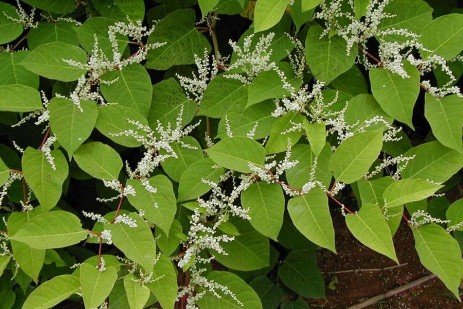Many types of herbicides will kill Japanese Knotweed (Fallopia japonica syn. Polygonum cuspidatum) such as Rodeo, Roundup, Touchdown, Landmaster, Ranger, Gallup and Pondmaster. These herbicides are very effective because they are all glyphosate based and can easily get rid of this difficult weed.

Spray the leaves of the Japanese Knotweed during the early autumn and late summer. During this time, the knotweed is in its flowering stage which means that it is taking in more nutrients to build up a reserve of food. Here Environet share some tips for the eradication of Japanese knotweed.
The Use Of Glyphosate To Kill Japanese Knotweed
Herbicides that contain glyphosate will surely kill this plant. Glyphosate also kills any other plants you spray it on including plants and flowers you favor. Due to this, the majority of gardeners simply prefer not to use any herbicides. However, Japanese Knotweed is quite difficult to kill and this type of herbicide is the most effective solution.
All glyphosate based herbicides are translocated herbicides and not contact herbicides. The use of contact type herbicides to kill Japanese Knotweed may appear to be successful, however, it isn’t since it only kills the shoots and leaves. As a result, using a glyphosate type of herbicide is best since it kills the leaves, shoots as well as the roots. It not only completely kills the plants but also kills any rhizomes which ensures that the plant won’t regrow over time.
Herbicides Which Eliminate Japanese Knotweed
Any herbicide containing glyphosates will kill Japanese knotweed. Some popular types include Glyphos Biactive and Roundup Biactive. Other ingredients that kill Japanese Knotweed are picloran and triclopyr. The most preferred herbicide for Japanese Knotweed contains glyphosate simply because it can be used near water.
Only use these herbicides on areas where you intend to have flower beds, lawns or other non-edible plants. Avoid using these types of herbicides in places where you would like to grow fruits and vegetables.
Chemical For Killing Japanese Knotweed
You can easily get glyphosate herbicides at your local garden center. Spray the product directly on the leaves. The plant takes the herbicide in all the way down to the rhizomes. Unfortunately, this takes a good bit of time and will need about 4 growing seasons in order to completely kill the plant and get rid of it. With that said, there are many Japanese Knotweed removal companies that can easily get rid of the plant since they have much more potent herbicides which will drastically reduce the removal time.
How To Get Rid Of Japanese Knotweed
The cheapest and most commonly used method is to spray the herbicide directly onto the plant. You can also do stem injections of the herbicide, especially if you want to protect neighboring plants.
Another removal method is through excavation. Basically, you can dig up the entire area to remove the entire Japanese Knotweed plant. You need to completely remove the plant and its root system and make sure that all rhizomes and fragments are completely removed. If any rhizomes or part of remains, then these can make a new Japanese knotweed plant regrow in the area. This particular removal method is the only method that can be used if the land has to be used for development.
Burning Japanese Knotweed
After you’ve removed the plant, you can then burn it after it has been completely dried out. Now, even though you may have completely burned the plant, it is still possible that it may have active rhizomes which can regrow into a new plant. So, after you’ve burned your Japanese knotweed, you should definitely call a removal company to dispose of it. Do not add it to your compost pile.
Alternatives
In order to stop the spread of this plant, you can use a root barrier. Insert the barrier 3 meters down. This works because the root of this plant only goes down up to 2 meters. The use of the barrier is quite effective for containing the Japanese knotweed infestation since the rhizomes won’t be able to penetrate the barrier.
